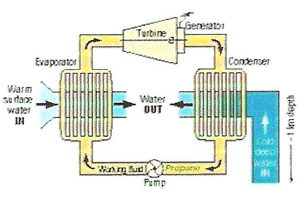hydrothermal power generation

The above modified graphic2 depicts a closed cycle organic Rankine cycle using propane as a working fluid. The cold water heat exchanger condenser functions to have the propane change state from a gas to a liquid while the warm surface water heat exchanger evaporator turns the propane into a gas. The gas, on its way to complete the cycle, gives up its energy to a turbine which turns a generator to produce electric power.
Many people understand the concept of hydroelectric power generation, such as at Niagara Falls, Canada, where electric power is generated by turbines positioned to take advantage of the potential energy of water at different heights. Similarly, hydrothermal power generation, also known as ocean thermal energy conversion (OTEC) is the practice of producing electric power from the potential energy of water temperature differences of at least 20°C (36°F).
Harvesting thermal energy from the ocean traces its roots to 1881 when French physician Jacques-Arsène d'Arsonval first proposed using a heat engine based on the work of Scottish engineer William Rankine. D'Arsonval surmised that "if pumps pull enough water through two separate sets of pipes, the warm seawater will evaporate a heat transfer liquid (such as ammonia or propane) in one part of the plant; elsewhere, cold seawater recondenses the gas to liquid. But as it blows from the first point of phase change to the second, the gas stage will drive a turbine".1 The physician-turned-ocean-scientist knew that coastal areas close to deep cold water and warm surface water could produce power from the temperature difference.
The abundance of this renewable energy source was testified by ocean energy scientist Hans Krock:
The energy flowing through the surface layer of the tropical ocean is about 10,000 times greater than the energy used by human societies. As such it is the only energy resource on earth that is large enough to replace fossil fuel. 3
The production of electrical power may be by an open cycle, which has the advantage of also producing fresh water, or a closed cycle. A closed cycle has the advantage of being more compact and possibly more cost effective. The adjacent figure is a representation of the closed organic Rankine cycle for producing electricity. HVAC professionals will recognize this cycle as the reverse of the air conditioning cycle.
There has been some research to improve the output and efficiency of an OTEC ORC system by integrating solar energy into the cycle. Yamada et al.4 illustrate two methods to integrate solar thermal energy with ocean energy. The "SOTEC a" concept uses solar collectors to preheat the ocean water prior to entry into the evaporator heat exchanger thereby increasing the temperature difference and energy potential. Yamada's "SOTEC b" involves superheating the working fluid with solar collectors to increase the energy potential. Using a warm water resource of 76°F in heat exchangers to evaporate propane (R-290) and a 40°F cold water heat exchanger to condense propane, a single-stage turbine generator could theoretically be manufactured to within the envelope of a 40-foot ISO container and produce 9.6 megawatts of power. Incorporating solar power indicated that over 40 megawatts of power could be generated from the same envelope.5 Much more work in research and development needs to be done to realize this potential but a path has been illuminated to generate power by collocating two temperature sources with a temperature difference of at least 20°C (36°F).
References
1. Chiles,
James R. "The Other Renewable Energy." Invention & Technology,
Winter 2009.
2. Inman,
Mason. "Sea Power, Part 1." Renewable Energy World. 3 Aug.
2009. Web. 22 July 2010.
3. Krock,
Hans. Testimony of Dr. Hans Krock re: Ocean Thermal Energy Conversion
(OTEC) LOL T-9 Public Utilities Commission Docket No. 05-0145 O`ahu
Power Plant. Pg. 4
4. Yamada, N., Hoshi, A., and Y. Ikegami. 2009. " Performance simulation
of solar-boosted ocean thermal energy conversion plant," Renewable
Energy 34: 1752–1758.
5. Jagusztyn,
Tadeusz F., Reny, Marie (2010). "Natural Cold Water District Cooling
Plants Enabled by Directional Drilling – Road to Climate Friendly Chillers"
UNEP–ASHRAE Conference, Sept 2010, Cairo, Egypt
